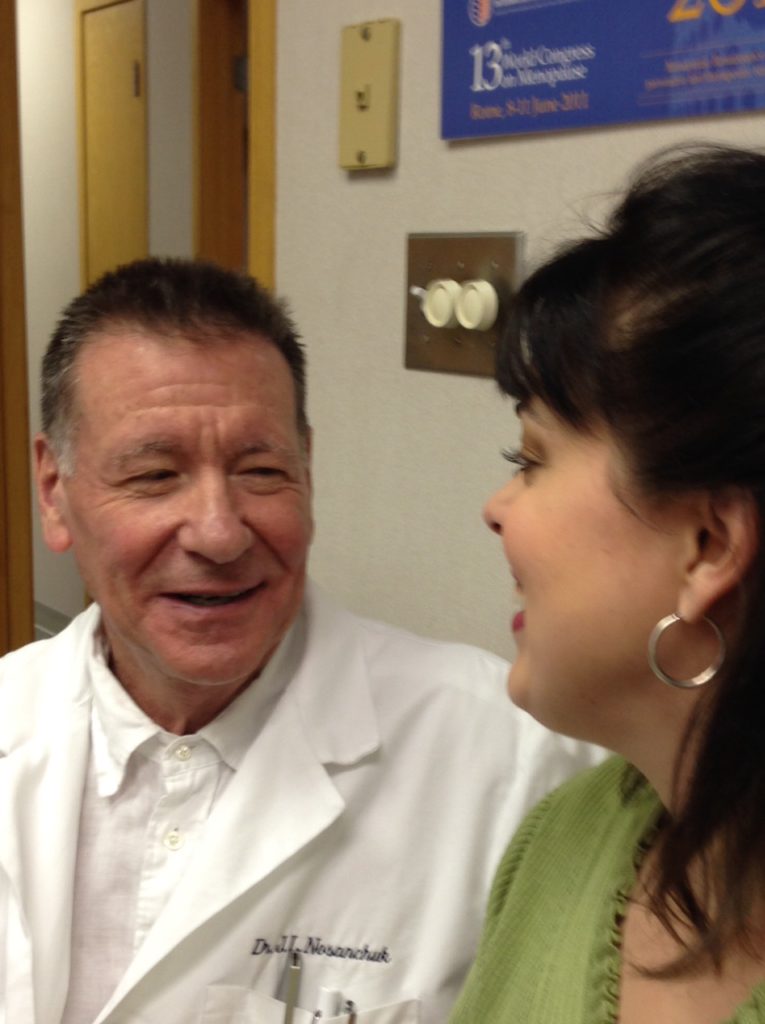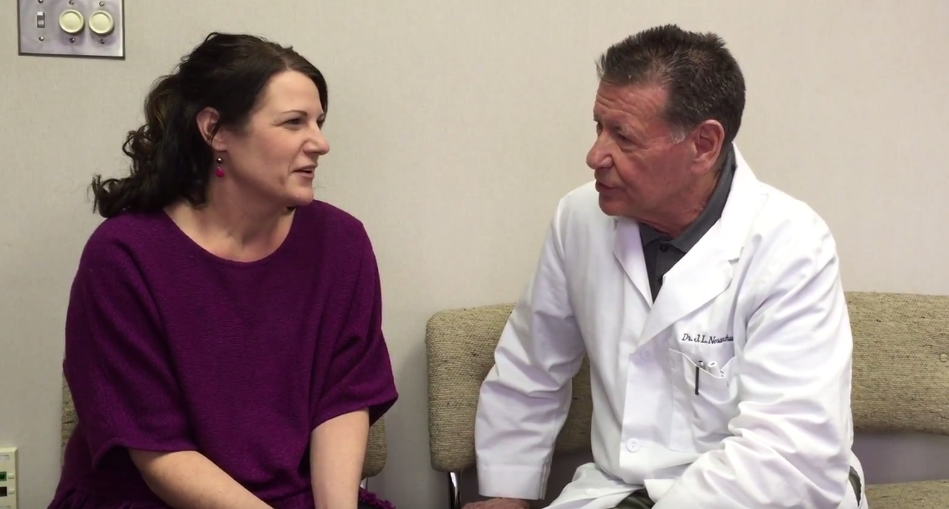Menopause Symptoms
WHAT CAUSES MENOPAUSAL SYMPTOMS?
They are directly related to the decline in sex hormone levels that accompany menopause. As hormone levels begin to diminish some women begin the have symptoms such as hot flashes and sweats long before they stop menstruating

WILL I HAVE MENOPAUSAL SYMPTOMS?
Every woman’s menopausal experience is unique; she may experience all of these symptoms or none of them. Some women may find the transition barely noticeable while others find it life altering. Menopausal women who experience no symptoms at all may be less inclined to consider hormone use if they believe hormone replacement is only for the relief of symptoms and are not aware of its preventive health care benefits.
WHAT ARE THE SYMPTOMS OF MENOPAUSE?
- Hot flashes/heat intolerance/sweats/chills
- Insomnia/fatigue/problems with memory and concentration
- Depression: diminished sense of well being, loss of self confidence, mood swings, irritability, headaches
- Palpitations
- Decreased interest in sex
- Muscle/joint pain
Hot Flashes, Sweats, Heat Intolerance and Chills:
The hot flash or the more descriptive term the hot flush is the symptom commonly associated with menopause. Many people are under the impression that hot flushes are the only significant manifestation of menopause, other than the cessation of regular menstrual cycles. When you here someone say, “I’ve gone through menopause”, or “I can’t wait until I’m done with menopause”, it is likely that they equate no longer having flushes as a sign that they have “gone through” menopause. However, no one “goes through” menopause. Once you become hormonally deficient you remain so for the rest of your life.
About 75% of women experience hot flushes, heat intolerance or sweats sometime during or prior to their menopause. Although these symptoms resolve within two years in most of those affected, they may last five years or more in approximately 20% of women. I have had patients in their 80’s in whom these symptoms persisted. Some patients experience chills in a similar fashion to the hot flush and it is likely a variant of the same phenomenon.

The hot flush can range from a barely perceptible feeling of warmth to intense heat of the chest, neck and head and can be accompanied by profuse flushing and sweats. Many women develop chronic heat intolerance in lieu of or in addition to flushing. They will often wear light clothing in the middle of the winter and prefer to set the thermostat in their homes at a level that is noticeably cool for the rest of their family. One patient told me that in the middle of the winter she would stand in her unheated garage several times a day as it was the only place she could find at least temporary relief for her discomfort. These patients are very uncomfortable in warm weather and many have told me that vacationing in a tropical climate was out of the question for them.
Mild flushing episodes can often be ignored but as they progress in intensity they can become annoying, distracting, embarrassing and in the worst case scenarios debilitating. Menopausal women often know when the flush is about to begin before they are aware of any sense of heat or flushing. Usually, women who have undergone ovarian removal experience the most severe symptoms and there may be associated nausea, urinary urgency or an impending sense of doom. The flushes can last from several seconds to as long as thirty minutes and sometimes as long as an hour and can occur from rarely to every ten to thirty minutes. They tend to be more frequent and severe during the night and often disturb sleep. Associated sweats may be so severe as to necessitate a change of sleepwear.
Women experiencing severe flushes may be unable to work and have difficulty performing the routine activities of daily living. A menopausal woman who is delivering a business presentation and has a severe flushing episode may find it difficult if not impossible to continue. Stressful situations, warm temperatures, alcohol, hot food, warm clothing and exercise are frequently precipitating factors. A menopausal woman’s difficulty with flushes tends to be taken lightly by those never having experienced the symptom, including other women. One will sometimes hear the phrase, “get over it”, spoken by people insensitive to how disturbing and unpleasant a flushing episode can be.
There is a story which appeared in a national news magazine a few years ago written by a woman who had recently become menopausal. In the article she describes how she felt during a flushing episode on a cold winter day while walking in a large northeastern city. Despite the cool weather and her open coat she was in considerable discomfort. Sweating profusely, she thought, “I’m sorry mom!”, as she remembered how years before she had lightly dismissed her mother’s readily apparent distress with similar flushes. The woman was remorseful for her failure to have been more supportive. Hot flushes, often the butt of jokes about menopause, may not be amusing to a menopausal woman whose quality of life is affected by them.
What causes hot flushes, sweats and heat intolerance?
These symptoms occur as a response to changing hormone levels which induce confusion (doctors refer to this as “vasomotor instability”) in the temperature regulating mechanism of the body. Your body “thermostat”, located in an area of the brain called the hypothalamus”, is intermittently fooled into believing that your body temperature should be lower. To accomplish this the “thermostat” sends signals that cause warm blood located in the core of your body to be brought to dilated blood vessels in the surface of your skin where it can be cooled by the surrounding air. The “sweats” some women experience is a more extreme cooling measure. Evaporation of liquid in the form of perspiration from the skin is utilized to reduce body temperature. If you recall how chilled you feel when you get out of a swimming pool or a bath, you can see how effective evaporation is as a cooling mechanism.
Is there a treatment for hot flashes, sweats and heat intolerance?
Hormone replacement therapy, using estrogen and if needed testosterone, is the most effective treatment. All the regimens of HRT in routine usage today will relieve the majority of menopausal women of these symptoms. Whichever regimen is used, must be taken on a regularly basis for as long as a month to resolve symptoms. If a program does not prove to be effective, a slightly higher dose of the same preparation can be tried and if this is not successful one of the other routes of administration should be given a trial. I have found that changing preparations that are administered using the same route of administration is not as effective in relieving resistant symptoms as changing to a preparation that utilizes an alternate route of administration.
The treatment program that is almost always successful even if symptoms have been longstanding and resistant to other methods of hormone replacement is subcutaneous implantation of the appropriate dose of estradiol and, if indicated, testosterone. I have seen patients who had symptoms for as long as thirty years or more in spite of various types of HRT treatment, whose symptoms resolved with this route of administration. One of these patients was in her early 80’s and had experienced flushes and sweats from the time of her hysterectomy around age 40. Another told me that until she had the subcutaneous implantation she had slept in a chair for over 20 years, as she was too uncomfortable sleeping in a bed.
Although not as effective, patients who cannot or prefer not to take estrogen may be treated with progesterone. Historically Provera, (medroxyprogesterone acetate) and Megace, (megestrol acetate) have been used for this purpose.
For a more in depth information about hormone replacement therapy, look at the About Hormone Replacement Therapy, Methods of Hrt and Regimens sections of the web site.
Some women are more comfortable with treatments they are able to obtain themselves without a prescription at a drug store, health food store, or from a herbalist. These therapies are sometimes used as complementary therapies along with prescription treatments. Non prescription therapies are advertised widely and are available at the local pharmacy. One of the most popular is vitamin E taken in a dosage of up to 400 IU daily. Natural and alternative therapies include foods containing plant estrogens called phytoestrogens and herbal remedies. Soy is an excellent source of phytoestrogen and a daily intake of soy products may be helpful. Herbal remedies that are reputed to have estrogenic activity include Dong quai, Ginseng, and Gotu kola. Unfortunately, there has not been enough research in this area and much needs to be done to establish proper dosage, safety and efficacy. Although some women may find that some of their symptoms are alleviated by these therapies, there is no evidence at present that they prevent long-term consequences of lowered hormone levels.
Menopause Overview
This page defines and discusses menopause, surgical menopause and premature menopause…
Sex and Menopause
Loss of sexual desire and ability to participate in and enjoy sex is not a normal part of aging. Dr Nosanchuk explains why a menopausal woman’s desire to have sex and her capacity to physically participate in sex are both affected by her menopause…
Menopause & Weight Gain
Dr Nosanchuk discusses the factors that influence weight gain in menopausal women…
Menopause & Migraine
This section discusses the nature of migraines and its relationship to menopause and hormone levels. In addition it provides strategies that may reduce the number and frequency of headaches…
Menopause & Hair Loss
One of the concerns shared by women of menopausal age is the possibility of hair loss. The importance modern society associates with an attractively styled hairdo is reflected by a thriving multi-billion dollar industry involved in the cutting, styling, washing and coloring of hair. When hair loss occurs to a menopausal woman, it is certainly stressful, as this situation may diminish body image satisfaction and self-esteem. The impact can be devastating and affect psychological adjustment and quality of life …